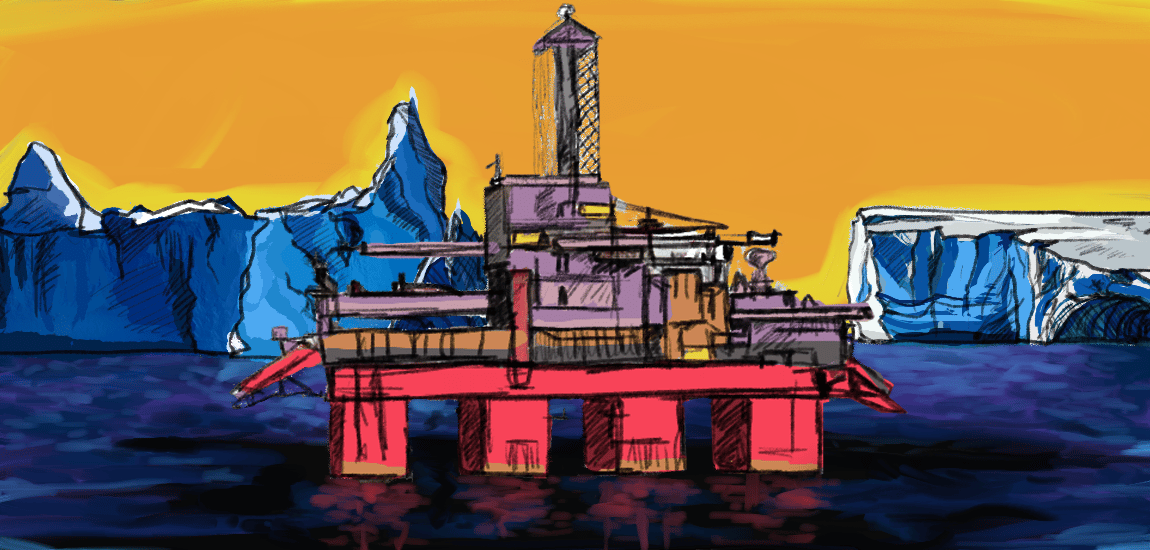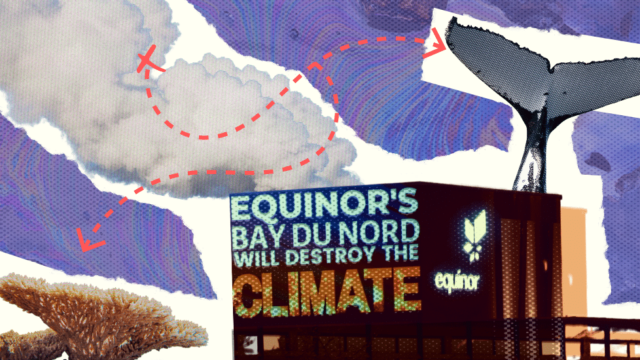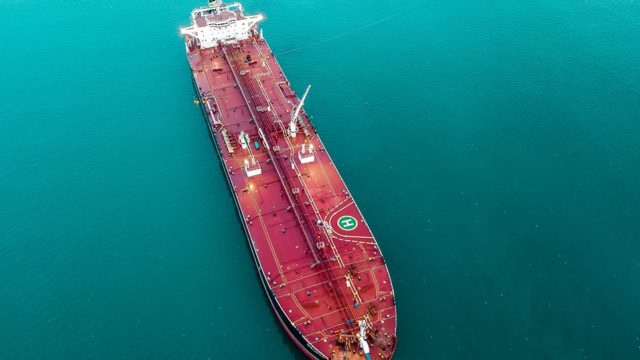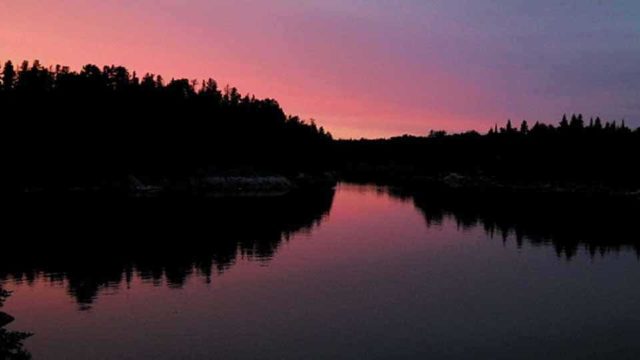Canada likes to tout itself as a global climate leader. Just last month, at an international summit hosted by Canada in Stockholm, Sweden, Minister of the Environment and Climate Change Steven Guilbeault sang the praises of the country’s aggressive approach to reducing greenhouse gas (GHG) pollution through its recently introduced climate accountability legislation.
But amidst this trumpeting, Canada has continued to permit extensive new oil and gas development, most recently, off the coast of Newfoundland and Labrador. On May 31, Cenovus Energy announced it will restart the West White Rose oil and gas project in the Newfoundland and Labrador offshore, a move that province’s government was quick to support.
And back in April, Minister Guilbeault approved Equinor Canada’s Bay du Nord offshore oil project, a carbon bomb₁ that could produce up to one billion barrels of oil over its lifetime. This approval came just days after the head of the United Nations called the development of new fossil fuel projects “moral and economic madness.”
So, what gives? How can the federal government claim to be a ‘climate leader’ and laud its commitment to achieving net-zero GHG pollution by 2050 while at the same time continuing to greenlight massive new oil and gas extraction projects?
Canada’s sly climate loophole
The trick to Canada’s climate sleight of hand is questionable accounting for GHG pollution generated by the oil and gas industry.
Canada’s Net-Zero Emissions Accountability Act requires the government to develop credible, science-based emissions-reduction plans to achieve net-zero greenhouse gas pollution by 2050. This includes oil and gas, which is the most polluting sector in the country, accounting for roughly 25 per cent of all GHG pollution.
The most recent plan released under this law aims to reduce GHG pollution from Canada’s oil and gas industries by 42 per cent by 2030. However, Canada’s plan for how to get there remains deeply flawed, including failing to count the full scope of emissions generated by these projects, including hidden downstream emissions.
Downstream emissions refer to GHG pollution that is released into the atmosphere when oil and gas is burned. A whopping 90 percent of GHG emissions from the oil and gas industry come from the burning of its products, and only 10 per cent from their production.₂ Given that Canada exports most of its oil for burning abroad, these emissions will never be accounted for in Canada’s own climate tally. Data from Environment Canada — secured by Ecojustice — reveals that between 2012 and 2019, Canada’s exported emissions from the sale of oil, gas and coal increased an alarming 46.43 per cent.
What does this mean? Because the lion’s share of GHG pollution is created when oil and gas is burned for energy, it means that even if Canadian oil and gas producers substantially reduce their emissions at the site of production, it will only have a minimal impact on actually reducing the total amount of GHG pollution generated from oil and gas industries.
This fatal oversight in the legislation is entirely by design. Canada’s climate law allows for the government and the country’s oil and gas industries to give the impression that they’re reducing carbon emissions, while in fact the real-world result is that they can continue to rise unchecked by exporting the vast majority of GHG pollution abroad. This was a policy choice taken globally way back in 1992 when the United Nations Framework Convention on Climate Change (UNFCCC) framework was first established, that still applies via the Paris Agreement. As the climate crisis intensifies, this approach is simply not tenable. Canada could be a leader in the shift towards a more accountable and transparent approach.
Because of this loophole, it’s entirely conceivable that in the next decade – the time during which climate scientists have warned us we must definitively transition away from fossil fuels – Canada will in fact increase its oil and gas production and will be directly responsible for increasing global emissions, all while claiming that the oil and gas sector is reducing emissions in line with the country’s net-zero targets. In other words, Canada’s climate laws regulating the oil and gas industry are at best toothless, and at worst, an Orwellian-level greenwash. We are reducing GHG emissions by increasing them. Any questions?
Canada’s Impact Assessment Act is being subverted to reinforce the loophole
In the absence of effective federal climate legislation that actually takes into account the hidden emissions from oil and gas extraction; impact assessments (IAs) can (and should) serve as climate gatekeepers. When IAs fail to consider the full scope of a project, including downstream emissions, it means that even projects that will cause exorbitant emissions can receive the greenlight from the government.
The recently approved Bay du Nord oil and gas project in the Newfoundland and Labrador offshore is a clear example. Equinor (and the Canadian government) argue this project will be less ‘carbon intensive’ than other forms of oil and gas development like fracking or Alberta’s tar sands. Equinor has even claimed that its Bay du Nord operation will be carbon neutral by 2050 (not to mention, most of the oil is expected to already be extracted by 2050, effectively making this carbon neutral pledge worthless). Yet, we know that the project will create up to 1 billion barrels of oil, which when burned will generate 400 million tonnes of carbon — that’s the equivalent of the emissions from 7-10 million cars per year.
The impact assessment for this project, and the Minister’s subsequent approval, failed to consider any of these catastrophic emissions. And moreover, it is being framed by provincial leaders, the federal government, and Equinor as fitting Canada’s “net-zero” federal strategy (which itself fails to consider downstream emissions). The idea that this project could in any way be considered carbon neutral and help reduce emissions is a convenient untruth – in other words, simply false.
When considering the climate impacts of a project, it is imperative that emissions from the entire lifecycle of the project be assessed: upstream, direct, and downstream emissions. This accountability would serve Canada’s moral imperative to promote domestic and international best efforts to reduce emissions and would ensure Canada was fully in compliance with its domestic legal obligations under the Impact Assessment Act.
(Green)washing our hands of accountability for downstream emissions
How Canada is currently implementing its legal regime to reign in carbon emissions from oil and gas isn’t just fundamentally flawed, it’s designed to keep the oil flowing at all costs through an accounting trick that concentrates on our domestic emissions while ignoring the massive amounts of emissions we export. And this greenwash is brought to you by your own tax dollars – in its most recent budget, the federal government provided a $7.1 billion subsidy subsidy to Canada’s oil producers to install carbon capture technology in their production facilities. This unproven band-aid solution technology does nothing to rein in downstream emissions but everything to create the perception that Canadian oil is ‘clean’ and ‘green.’
For those of you at the back of the room, it’s worth repeating: there is no such thing as “green” oil and gas.
A recent report published in the journal Nature₃ warned that about 60 per cent of global oil and gas reserves must stay underground by 2050 if we are to avoid the worst consequences of the climate crisis (some experts put that number as high as 80 per cent for Canada). Despite this, the government continues to fast-track oil and gas exploration off the coast of Newfoundland and Labrador and approve more extraction projects.
We should not be surprised if the federal government continues to approve new oil and gas projects in Canada’s offshore regions because these fit the ‘low carbon intensity’ regime. These approvals gloss over Canada’s accountability for the massive GHG emissions these projects will ship abroad.
Holding the government accountable
Ecojustice remains committed to holding the government accountable for properly assessing carbon-intensive projects in the offshore and across the country. If allowed to go ahead, these projects will have disastrous impacts in our fight against climate change. We’re suing the federal government for failing to properly assess the impacts of exploratory drilling in Newfoundland and Labrador’s offshore waters. Most recently, Ecojustice, on behalf of Équiterre, Sierra Club Canada Foundation and Mi’gmawe’l Tplu’taqnn Inc., filed a lawsuit against Minister Guilbeault’s approval of Bay du Nord. If successful, the Bay du Nord case could set a precedent that impact assessments must take hidden emissions into account.
If Canada is serious about reducing emissions and being on the forefront of the fight against climate change, the transition to a cleaner, sustainable, and prosperous economy must be both an immediate priority and a sustained effort in the decades to come. That means keeping oil and gas in the ground and strengthening investment in cleaner, renewable energy sources. It means filling the loophole in Canada’s climate legislation and ensuring impact assessments are done right, so they consider the emissions generated during the entire lifecycle of a project – including downstream emissions. There’s still time for Canada to become the climate leader it already purports to be.
References
₁Revealed: the ‘carbon bombs’ set to trigger catastrophic climate breakdown
₂Global warming of 1.5°C: An IPCC Special Report
₃Unextractable fossil fuels in a 1.5 °C world







